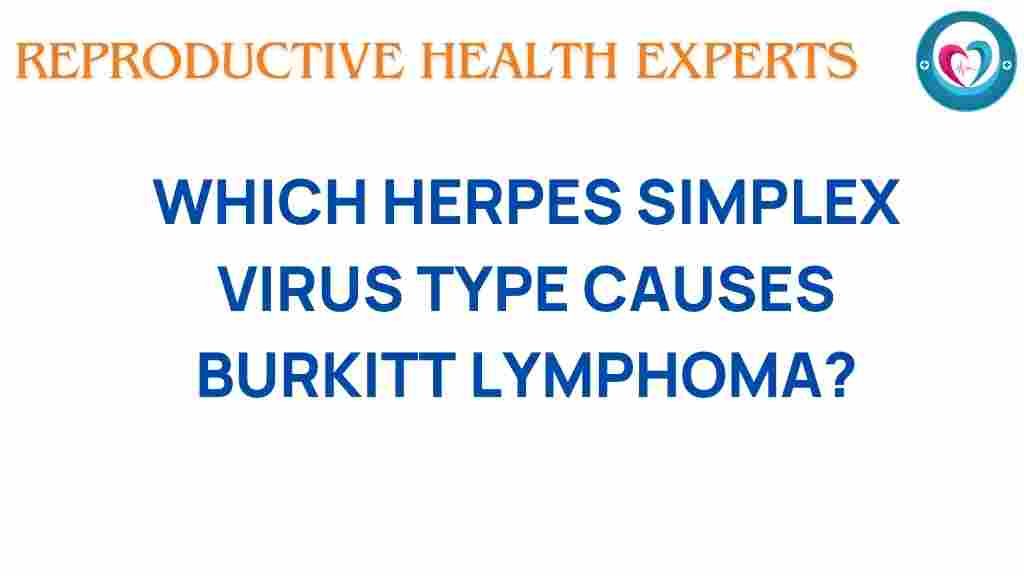Unraveling the Link: Which Herpes Simplex Virus Type Triggers Burkitt Lymphoma?
Burkitt lymphoma is a type of non-Hodgkin lymphoma that is highly aggressive and typically occurs in children and adolescents, although it can also affect adults. Its association with various viral infections has long been a subject of research within the domains of cancer research and viral oncogenesis. Among the potential viral culprits, the herpes simplex virus (HSV) has been scrutinized for its role in triggering this type of lymphoma. In this article, we will explore the intricacies of how the herpes simplex virus relates to Burkitt lymphoma, the immune response involved, and the broader implications for health risks and understanding medical mysteries.
Understanding Herpes Simplex Virus and Burkitt Lymphoma
The herpes simplex virus (HSV) is a common viral infection that exists in two types: HSV-1 and HSV-2. While HSV-1 is primarily associated with oral herpes, and HSV-2 with genital herpes, both types can establish lifelong infections within the host. The connection between HSV and Burkitt lymphoma presents a compelling area of study in cancer research.
Burkitt lymphoma is characterized by the rapid growth of tumors, often in the jaw or abdomen, and is associated with the Epstein-Barr virus (EBV). However, researchers have begun to investigate the role of other viral infections, including herpes simplex virus, in the development of this lymphoma. Understanding this relationship requires a closer examination of viral oncogenesis and the immune response.
The Mechanisms of Viral Oncogenesis
Viral oncogenesis refers to the process by which viruses can lead to cancer development. In the case of Burkitt lymphoma, the interplay between viral infections and the host’s immune response is crucial. Here’s how the herpes simplex virus can be implicated:
- Direct Transformation: Some viruses can directly induce cellular transformation, leading to uncontrolled cell growth.
- Immune Evasion: Viruses like HSV can evade the immune system, allowing for persistent infections that may influence oncogenesis.
- Cytokine Release: Viral infections can alter cytokine profiles, leading to an inflammatory environment conducive to cancer development.
Immune Response: A Double-Edged Sword
The immune response plays a pivotal role in controlling viral infections and preventing cancer. However, in the case of herpes simplex virus infections, the immune response can have dual outcomes:
- Effective Clearance: In healthy individuals, a robust immune response can effectively clear HSV, preventing complications.
- Chronic Inflammation: In some cases, persistent HSV infections can lead to chronic inflammation, which is a known risk factor for various cancers, including Burkitt lymphoma.
Understanding this balance is essential for dissecting the health risks associated with HSV and its potential link to Burkitt lymphoma.
The Role of Herpes Simplex Virus in Burkitt Lymphoma
Research surrounding the herpes simplex virus and Burkitt lymphoma has yielded intriguing insights. While the direct causative link remains to be fully established, several studies have suggested potential mechanisms by which HSV might influence the development of this malignancy.
Recent Findings in Cancer Research
Recent studies have highlighted the following aspects regarding the link between the herpes simplex virus and Burkitt lymphoma:
- Co-Infection with EBV: Many Burkitt lymphoma cases are associated with co-infection by EBV. Some studies indicate that HSV may act synergistically with EBV, exacerbating the risk of lymphoma development.
- Viral Load Correlation: Higher viral loads of HSV have been correlated with an increased risk of developing lymphoproliferative disorders, including Burkitt lymphoma.
- Genetic Factors: Genetic predispositions may influence how individuals respond to viral infections, potentially increasing the risk of developing cancer.
Health Risks and Preventive Measures
Understanding the health risks associated with herpes simplex virus infections is crucial for prevention and management. Here are some preventive measures that can be taken:
- Safe Practices: Engaging in safe sexual practices can reduce the risk of HSV transmission.
- Regular Health Checkups: Regular screenings and checkups can help detect any abnormalities early.
- Awareness of Symptoms: Being aware of the symptoms of HSV and Burkitt lymphoma can lead to early intervention.
Troubleshooting Tips for Managing HSV
If you are dealing with herpes simplex virus infections, consider the following tips to manage the condition effectively:
- Antiviral Medications: Consult a healthcare provider about antiviral medications that can help manage outbreaks.
- Stress Management: Stress can trigger outbreaks, so practicing stress-relief techniques like yoga or meditation can be beneficial.
- Healthy Lifestyle Choices: A balanced diet, regular exercise, and adequate sleep can strengthen the immune response.
Conclusion: The Ongoing Quest in Cancer Research
As we unravel the complexities of the link between herpes simplex virus and Burkitt lymphoma, it becomes evident that further research is necessary to elucidate the underlying mechanisms. The interplay between viral infections, immune response, and genetic factors presents a multifaceted landscape in cancer research.
While the exact role of the herpes simplex virus in triggering Burkitt lymphoma remains a medical mystery, awareness of health risks and preventive measures can guide individuals in protecting their health. Understanding the nuances of viral oncogenesis is vital not only for researchers but also for those affected by viral infections.
For more comprehensive insights into viral infections and their implications for health, you can explore this resource that delves deeper into the subject. Additionally, stay updated with ongoing research by following reputable sources on medical research.
By continuing to study the connections between viral infections and cancer, we can pave the way for new preventive strategies and therapeutic interventions, ultimately reducing the burden of diseases like Burkitt lymphoma.
This article is in the category Conditions and created by ReproductiveHealthExperts Team
